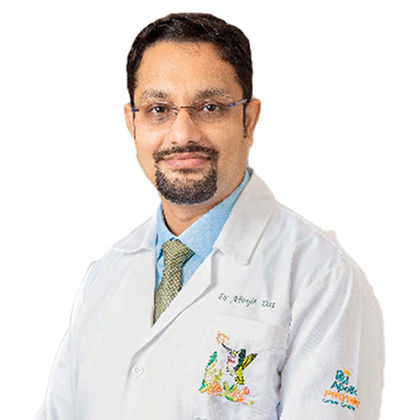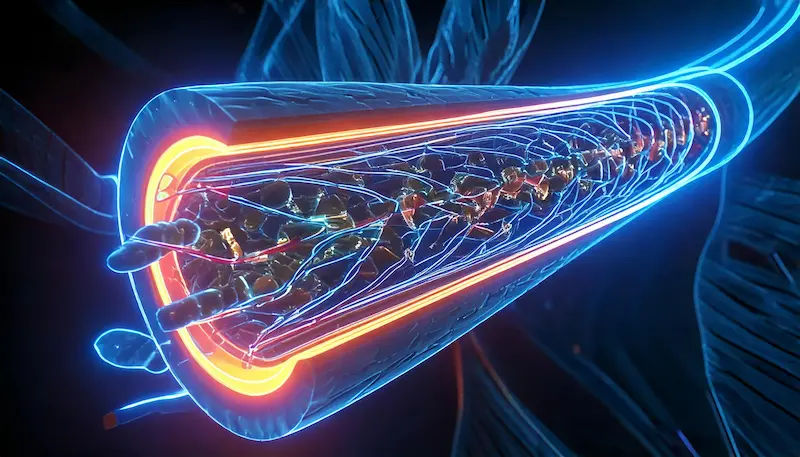Understanding Buerger's Disease: Causes, Symptoms, and Treatment Options
Learn about Buerger's Disease, a rare vascular condition that affects the blood vessels in the arms and legs. Discover its causes, symptoms, risk factors, and available treatment options to manage the disease effectively.

Written by Dr.Sonia Bhatt
Last updated on 3rd Jul, 2025

Buerger's disease, also known as thromboangiitis obliterans (TAO), is a rare but serious condition that primarily affects the blood vessels in the hands and feet. This disease causes inflammation and clotting of the blood vessels, leading to restricted blood flow and potential tissue damage. If left untreated, it can result in severe complications such as tissue death, gangrene, and, in extreme cases, amputation. While Buerger's disease is uncommon, it is important for patients and caregivers to understand its causes, symptoms, and treatment options. In this article, we will explore Buerger's disease in detail, offering actionable advice for those affected by it.
What is Buerger's Disease?
Buerger's disease is a type of peripheral artery disease (PAD), which means it affects the arteries that carry blood to the limbs rather than the heart. Unlike more common forms of PAD, Buerger's disease is characterised by inflammation and clotting in small and medium-sized blood vessels, particularly in the hands and feet. Over time, this inflammation leads to a narrowing and even blockage of blood vessels, resulting in poor blood circulation. This lack of blood flow can cause pain, ulcerations, and tissue damage in the affected limbs.
Causes of Buerger's Disease
The exact cause of Buerger's disease is not fully understood, but several factors are believed to contribute to its development. The condition is closely linked to smoking and tobacco use, with nearly all cases occurring in individuals who smoke or chew tobacco. In fact, the risk of developing Buerger's disease is significantly higher among smokers, and the disease typically begins in young, otherwise healthy individuals who have been smoking for years.
While smoking is the primary risk factor, other possible triggers and contributing factors include:
Genetics: There may be a genetic predisposition to Buerger's disease. Certain individuals with a family history of vascular diseases, autoimmune conditions, or inflammatory disorders may be more prone to developing Buerger's disease.
Autoimmune Response: Some researchers suggest that Buerger's disease could involve an autoimmune response, in which the body's immune system mistakenly attacks healthy tissues in the blood vessels, causing inflammation and clot formation.
Inflammation: Chronic inflammation, whether due to environmental factors or underlying conditions, is thought to play a role in the development of Buerger's disease. Inflammatory reactions can damage blood vessels, making them more prone to clotting and narrowing.
While smoking is the most well-established risk factor, Buerger's disease can occur in non-smokers in rare cases. Researchers continue to investigate other potential causes and risk factors for this condition.
Symptoms of Buerger's Disease
The symptoms of Buerger's disease can vary depending on the severity and progression of the condition. Common symptoms often include:
Painful limbs: As the blood vessels narrow and blood flow is restricted, patients often experience pain, especially in the hands, feet, and lower legs. This pain may be intermittent or persistent and may worsen with activity or in colder temperatures.
Coldness or discolouration: Poor circulation can cause affected limbs to feel cold or appear pale or blue in colour. This is due to reduced oxygen and nutrient supply to the tissues.
Ulcerations and sores: In more advanced stages, individuals with Buerger's disease may develop painful sores or ulcers on the fingers, toes, or other areas of the feet and hands. These ulcers can become infected if not properly treated.
Numbness or tingling: As blood flow continues to decrease, individuals may experience numbness, tingling, or a "pins and needles" sensation in the affected limbs.
Skin changes: In some cases, skin over the affected areas may become thickened or shiny, and hair loss on the affected limbs may occur.
Gangrene: In severe cases of Buerger's disease, the tissue in the hands or feet may become so deprived of oxygen that it begins to die, leading to gangrene. This is a serious complication that may require amputation if not addressed promptly.
Consult Top Vascular Surgeon
Diagnosis of Buerger's Disease
Diagnosing Buerger's disease can be challenging due to its rarity and the overlap of symptoms with other vascular conditions. To confirm the diagnosis, doctors typically perform a combination of the following tests:
Physical exam: A doctor will evaluate the patient's medical history, ask about smoking habits, and conduct a thorough physical exam to assess the symptoms and blood flow in the limbs.
Doppler ultrasound: This non-invasive test uses sound waves to measure blood flow in the arteries. It helps doctors identify areas where blood flow is restricted.
Angiography: In some cases, a doctor may recommend angiography, a procedure that uses dye and X-ray imaging to visualise the blood vessels and detect blockages or narrowing.
Blood tests: Blood tests may be done to rule out other conditions that could mimic Buerger's disease, such as autoimmune disorders.
Biopsy: In rare cases, a biopsy of the affected tissue may be performed to check for signs of inflammation and blood vessel damage.
Treatment of Buerger's Disease
There is no cure for Buerger's Disease, but several treatment options can help manage the symptoms and prevent disease progression. The primary goal of treatment is to improve blood flow, relieve pain, and prevent complications.
Quitting Tobacco Use
The most crucial step in treating Buerger's Disease is quitting all forms of tobacco use. This includes smoking cigarettes, cigars, and pipes, as well as using smokeless tobacco products. Quitting tobacco use can help prevent further damage to the blood vessels and improve symptoms. It is essential to seek support from healthcare professionals, support groups, and smoking cessation programs to quit successfully.
Medications
Several medications can help manage the symptoms of Buerger's Disease and improve blood flow:
Vasodilators: Medications that relax and widen the blood vessels, such as iloprost and cilostazol, can help improve blood flow and reduce pain.
Antiplatelet Agents: Drugs like aspirin and clopidogrel can prevent blood clots from forming and reduce the risk of blockages in the blood vessels.
Pain Relievers: Over-the-counter pain relievers, such as acetaminophen and ibuprofen, can help manage pain associated with Buerger's Disease.
Compression Therapy
Wearing compression stockings can help improve blood circulation in the affected limbs and reduce swelling. Compression therapy can be particularly beneficial for individuals with venous insufficiency.
Surgical Procedures
In severe cases of Buerger's Disease, surgical procedures may be necessary to improve blood flow and prevent complications:
Surgical Sympathectomy: In some cases of Buerger's disease, a procedure called surgical sympathectomy may be recommended to help improve blood flow to the affected limbs. This surgery involves cutting or removing specific nerves that control blood vessel constriction. These nerves are part of the sympathetic nervous system, which controls automatic functions like narrowing and widening blood vessels. By cutting these nerves, the blood vessels can remain more open, allowing blood to flow more freely to the hands and feet. This can help relieve pain and improve circulation, especially in people who haven't had success with other treatments.
Amputation: In severe cases of Buerger's disease, where blood flow has been so damaged that the tissue in the affected limb begins to die (a condition called gangrene), amputation may be necessary. Amputation involves removing the affected part of the limb—such as a toe, foot, or even part of the leg—to prevent the infection from spreading and to save the person's life. While it’s a difficult decision, amputation is sometimes the last resort when all other treatment options have failed. It's important to work closely with a doctor to explore all options before considering this step.
Lifestyle Changes and Prevention
Living with Buerger's disease can be challenging, but making certain lifestyle changes can help manage the condition and improve overall health. Here are some steps to take:
Adopt a healthy diet: A heart-healthy diet that is low in saturated fats and high in fruits, vegetables, and whole grains can help support vascular health and reduce the risk of complications.
Exercise regularly: Low-impact exercises, such as walking or swimming, can help improve circulation and maintain overall cardiovascular health.
Stay warm: Keep the affected limbs warm and avoid exposure to extreme temperatures, as cold weather can worsen symptoms.
Manage stress: Chronic stress can exacerbate inflammation in the body, so practising stress-management techniques like yoga, meditation, or deep breathing can be beneficial.
Conclusion
Buerger's Disease is a serious condition that can significantly impact an individual's quality of life. While there is no cure, early diagnosis and appropriate treatment can help manage the symptoms and prevent complications. Quitting tobacco use is the most crucial step in managing Buerger's Disease, and individuals with this condition should seek support to quit successfully. By making healthy lifestyle choices and working closely with healthcare providers, individuals with Buerger's Disease can improve their quality of life and reduce the risk of severe complications.
Consult Top Vascular Surgeon
Consult Top Vascular Surgeon

Dr. Lal Daga
Cardiologist
20 Years • MBBS, DNB [MED], DNB [CARDIO], FESC [INT], MNAMS
Ahmedabad
Apollo Hospitals Gandhinagar, Ahmedabad

Dr. Prakash Goura
Vascular and Endovascular Surgeon
8 Years • MBBS , DNB ( GENERAL SURGERY) , MRCS, MCh ( VASCULAR & ENDOVASCULAR SURGERY)
Hyderabad
Apollo Hospitals Jubilee Hills, Hyderabad
(50+ Patients)

Dr Yashpal Singh
Vascular and Endovascular Surgeon
18 Years • MBBS, MS (Gen. Surgery), DNB ( Peripheral Vascular Surgery)
Lucknow
Apollomedics Super Speciality Hospital, Lucknow

Dr. Abhijit Das
Surgical Oncologist
10 Years • MBBS MS, MCh (Surgical Oncology), Fellowship in Thoracic Oncology (SNUK, Korea), Fellowship in Advance Esophageal Surgery (NCC, Japan)
Chennai
Apollo Proton Cancer Center, Chennai

Dr. Nikhila Pinjala
Vascular and Endovascular Surgeon
7 Years • MBBS, M.S(Gen),DNB (Vascular)
Hyderabad
Apollo Hospitals Jubilee Hills, Hyderabad
(25+ Patients)
Consult Top Vascular Surgeon

Dr. Lal Daga
Cardiologist
20 Years • MBBS, DNB [MED], DNB [CARDIO], FESC [INT], MNAMS
Ahmedabad
Apollo Hospitals Gandhinagar, Ahmedabad

Dr. Prakash Goura
Vascular and Endovascular Surgeon
8 Years • MBBS , DNB ( GENERAL SURGERY) , MRCS, MCh ( VASCULAR & ENDOVASCULAR SURGERY)
Hyderabad
Apollo Hospitals Jubilee Hills, Hyderabad
(50+ Patients)

Dr Yashpal Singh
Vascular and Endovascular Surgeon
18 Years • MBBS, MS (Gen. Surgery), DNB ( Peripheral Vascular Surgery)
Lucknow
Apollomedics Super Speciality Hospital, Lucknow

Dr. Abhijit Das
Surgical Oncologist
10 Years • MBBS MS, MCh (Surgical Oncology), Fellowship in Thoracic Oncology (SNUK, Korea), Fellowship in Advance Esophageal Surgery (NCC, Japan)
Chennai
Apollo Proton Cancer Center, Chennai

Dr. Nikhila Pinjala
Vascular and Endovascular Surgeon
7 Years • MBBS, M.S(Gen),DNB (Vascular)
Hyderabad
Apollo Hospitals Jubilee Hills, Hyderabad
(25+ Patients)

